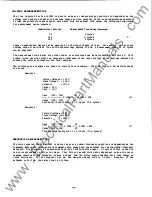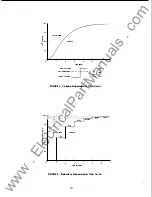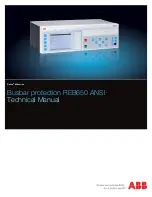
OUTPUTS
Isolated Trip contact:
The llser must choose between the Standard, Alternate or Pulse output relay
oonfigurations which will determine if the output relay is energized or de-energized in the Trip state.
The Trip state is defined as when any parameter is out of s pecification after the appropriate time
delay_
The Close state is defined as when all conditions are within acceptable ranges and the
reconnect time is complete.
Standard Relay Configuration:
The output relay will de-energize when the PRIDE"is in the Trip state.
and energize when in the Close state.
Alternate Relay Configuration:
The output relay will energize when the PRIDE is in the Trip state,
and de-energize when in the Close state.
Pulse Relay Configuration:
The output relay will pulse energize for
0.5
sec when the
PRIDE
is in the
Trip state, and will remain de-energized in the Close state.
When power to the unit is lost or a Self-Test error is detected, the output relay will de-energize.
This is the Trip state in the Standard Relay Configuration and the Close state in the Alternate or
Pulse Relay Configuration.
The Standard Relay Configuration was designed to trip the unit when power is lost or when a Self-Test
error occurs. The Alternate Relay Configuration is used to prevent tripping due to loss of power or
failures detected in the Self-Test routines. The Pulse Relay Configuration can be used in circuit
breaker applications where the user wants the trip signal to
be
momentary.
The user must also choose the type of contact desired (i.e. Normally Open or Normally Closed) in the
Trip state.
The
oontact type can
te
changed by the user if required.
Contact Rating: 6 A at
250
V ac,
80%
P.F. make and break;
10
A at
120
Vac,
80%
P.F. make and break;
5
A at
125
V dc make and carry only. Output contacts are not rated for interruption of dc circuits
unless external arc suppression is
used.
Consult the factory for advice concerning dc interruption.
Power Loss
Contact:
This is a normally closed oontact that opens when
the
correct supply voltages are
present
and
the supply is operating properly.
LED INDICATORS
The
POWER
OK LED will remain on as long as power is applied to the unit and the power supply is
operating properly.
All other LEOs will remain off when conditions are within limits.
Appropriate
LEOs
will light when an over or under limit condition occurs.
If an error is detected in the Self-Test routine of the microprocessor. an LED will flash indicating
the
source of the error.
In addition, if
the
unit is purchased with the optional
M-Q297/M-0397
Field
Adjustment unit, the status LEOs can also be used to display trip target conditions by activating a
pushbutton.
Refer to the
PRIDE
Instruction Book for further details.
TESTIRG FEATURE
'!he M-0290 can be
disconnected from the system inputs, using an internal connector. to allow complete
functional testing off-line.
M-031S
TEST ADAPTER OPTION
nu, M-031S can be
purchased to ease the functional testing of the
M-0290.
The Test Adapter consists of
a phenolic enclosure containing
14
five-way binding posts and a five foot extension cable with two
www
. ElectricalPartManuals
. com





































